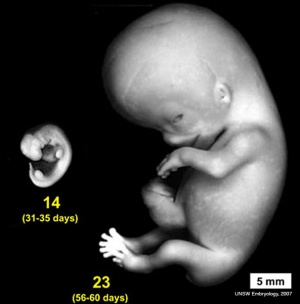Main Page: Difference between revisions
mNo edit summary |
mNo edit summary |
||
| Line 16: | Line 16: | ||
</imagemap> | </imagemap> | ||
[[File:Mark Hill.jpg|thumb|110px|Dr Mark Hill]] | [[File:Mark Hill.jpg|thumb|110px|Dr Mark Hill]] | ||
{{CURRENTDAYNAME}} {{CURRENTDAY}} {{CURRENTMONTHNAME}} {{CURRENTYEAR}} | {{CURRENTDAYNAME}} {{CURRENTDAY}} {{CURRENTMONTHNAME}} {{CURRENTYEAR}} | ||
Revision as of 09:59, 20 February 2017
| ||||||||||
|
Friday 26 April 2024 IntroductionWelcome to the Embryology education and research website in its 20th year online! There are many ways to find what you are looking for. Click on the left image term or use the page top menu items or the search window.
Start HereThis is the Main Page of the website, clicking the top lefthand icon or the menu item will always bring you to here. There are several different ways to find what you are looking for: click the major topic on the large left hand image, the Site Map also links to major topic sections, the Category option will show related materials, or simply use the search box.
| ||||||||||
| Embryology around the world (use the translate link by clicking Expand at the top of each page to change to your language) - embryologie (German, French, Dutch, Czech), embriología (Spanish, Italian, Portuguese), embryologi (Norwegian), embryologia (Finnish), embryoleg (Welsh), embriologi (Indonesian), embrayolohiya (Filipino), εμβρυολογία (Greek), эмбриология (Russian), 発生学 (Japanese), 胚胎 (Chinese), 발생학 (Korean), תוֹרַת הַעוּבָּר (Hebrew), علم الأجنة (Arabic), رویان شناسی (Persian), கருவியல் (Tamil), गर्भवृद्धिशास्त्र (Marathi), วิชาว่าด้วยระยะแรกเริม (Thai)
|
Glossary Links
- Glossary: A | B | C | D | E | F | G | H | I | J | K | L | M | N | O | P | Q | R | S | T | U | V | W | X | Y | Z | Numbers | Symbols | Term Link
Cite this page: Hill, M.A. (2024, April 26) Embryology Main Page. Retrieved from https://embryology.med.unsw.edu.au/embryology/index.php/Main_Page
- © Dr Mark Hill 2024, UNSW Embryology ISBN: 978 0 7334 2609 4 - UNSW CRICOS Provider Code No. 00098G







